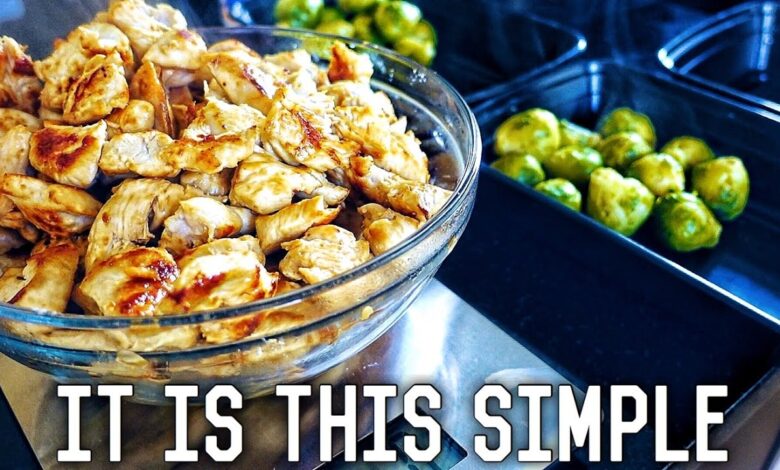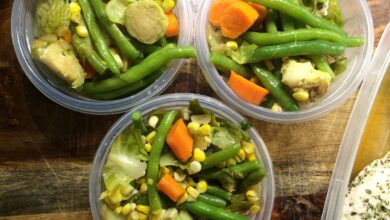
Embarking on a weight-loss journey can feel like climbing a steep mountain—steep, exhausting and full of unexpected plateaus. But what if there’s a smoother path? Introducing purposeful meal prep combined with a low-carb approach can be your rope, harness, and steady boots all at once. Let’s walk through how low-carb meal prep for weight loss can transform your routine, your body and your mindset.
Read Also 5 Easy Low-Carb Meal Prep Recipes for Weight Loss That Work Everywhere
What is Low-Carb Meal Prep?
Meal prep—planning, cooking, storing meals ahead of time—paired with low-carbohydrate eating principles, means you build meals in advance that are centered around fewer carbs (especially refined ones), more lean proteins, healthy fats and non-starchy vegetables. The aim is to remove day-to-day decision fatigue (“What do I eat now?”), stay consistent, and elevate your chances of making weight-loss progress.
Why low-carb? Carbohydrates are the body’s usual “go-to” energy source, but by reducing them and focusing on other macros, you shift the metabolic terrain—your body can rely more on stored fat, you feel fuller longer and you avoid the typical sugar/carb spikes and crashes. According to the Mayo Clinic, limiting carbs helps the body burn stored fat for fuel, which leads to weight loss. (Mayo Clinic)
When you combine both meal prep + low carb: you get structure, clarity and habit reinforcement. It’s not about perfection; it’s about consistent strides. So… ready? Let’s dig into eight major benefits.
Benefit 1: Simplified Routine & Reduced Decision Fatigue
When you’re prepping meals ahead of time—say for your week—you’re removing the daily scramble of “What’s for dinner? Should I order out? Will I reach for snacks?” With a low-carb meal-prep plan, you have those meals ready, built around your macros, aligned with your strategy.
This matters because decision fatigue is real. Every time you open the fridge, you face a choice. Over time, these tiny decisions drain your willpower and often lead to less-optimal choices (hello, high-carb take-out!). By meal prepping, you neutralize that risk. You’re acting ahead.
Also, when you design low-carb meals ahead of time—roasted chicken + cauliflower rice + green veg, for example—you ensure macro alignment (lower carbs, moderate protein, healthy fats). This helps you stay within your target without constant mental tracking. As one meal-prep guide noted: it “saves time: preparing meals in advance means less daily cooking and cleaning, freeing up time for other priorities.” (Healthy Fresh Meals)
In short: meal prep makes your weight-loss journey less “reactive” and more “proactive”. Less stress, fewer late-night carb binges, more predictability.
Benefit 2: Enhanced Satiety (Feeling Fuller Longer)
Ever eaten a high-carb meal and two hours later you’re rummaging for snacks? That’s because simple carbs release quickly into glucose, spike insulin, then you crash. With low-carb meals—especially those rich in lean proteins, fiber-rich veggies and healthy fats—you’re setting your body up for greater satiety.
The Mayo Clinic explains that low-carb diets may lead to greater short-term weight loss because the added protein and fat help you feel full longer, which helps you eat less. (Mayo Clinic)
When you prep low-carb meals ahead of time, you can include combinations like eggs + veggies + avocado, or grilled fish + broccoli + olive oil. These meals digest more slowly, keep your appetite in check and reduce the risk of impulsive snacking.
For folks in Africa, the US, or Europe, the value is the same: controlling hunger means you stay on track. The fewer times you get tempted by high-carb snacks, the more calories you avoid unintentionally. And when calorie intake stays aligned with your goals, weight-loss momentum grows.
Benefit 3: Better Blood-Sugar Control & Fat Storage Reduction
One of the hidden keys behind weight gain is elevated insulin. When you eat high-carb meals, especially processed carbs, your body floods insulin to manage the glucose spike. Over time, this can lead to insulin resistance, higher fat storage, and difficulty losing weight.
Low-carb meal prep helps you regulate this. The Harvard Health Publishing article on “Low-carb foods” explains that by reducing carbohydrate intake and replacing with proteins, fats and non-starchy vegetables, you improve opportunities for better blood-sugar stability. (Harvard Health)
When you plan your meals ahead: you choose slow-digesting carbs (if any), lots of fiber, lean proteins. You reduce the “spike-and-crash” effect. The body spends less time in fat-storage mode and more in fat-utilization mode. The Mayo Clinic also reinforces that low-carb diets help the body burn stored fat for energy. (Mayo Clinic)
For anyone—whether in Ghana, London or New York—this benefit helps weight-loss feel less like a constant uphill battle and more like a controlled process.
Benefit 4: Efficient Fat Loss With Muscle Preservation
A common fear when losing weight: “Am I going to lose muscle too?” The answer: it depends. With high-protein, low-carb strategies, and meal prepping to ensure consistency, you set up a scenario where your body can burn fat, not muscle.
WebMD emphasizes that high-protein, low-carbohydrate diets can lead to metabolic and appetite changes that make you feel full longer and help build muscle mass while losing body fat. (WebMD)
When you prep meals, you can ensure you have a lean protein source in each. For example: turkey breast, salmon fillet, eggs, legumes (in moderate-carb versions). Pair those with vegetables and healthy fats. This constant supply means your body has the amino acids it needs to maintain muscle, even as you’re in a calorie-deficit.
Translation? You’re preserving lean tissue, boosting metabolic rate, and burning fat. That’s a premium result.
Benefit 5: Reduced Cravings & Late-Night Eating
Cravings often come at moments of fatigue, low willpower, or when your meals are too high in quick-carb food. Meal prepping low-carb options gives you charged “weapons” in the armory against those moments.
When you already have a prepared meal that fits your macros, you’re far less likely to reach for a sugary snack or order take-out full of hidden carbs. The structured approach reduces impulsive decisions.
Also, because your meals keep you full longer (as covered earlier), the frequency of hunger pangs drops. When hunger signals drop, cravings drop. When cravings drop, adherence improves. It becomes a virtuous cycle.
This benefit is particularly important across cultures—whether you’re juggling work in Accra, commuting in the US, or balancing life in Europe. The prepared meals travel, fit into busy days, and help you avoid the “I’ll grab whatever” trap.
Benefit 6: Improved Nutrient Quality & Portion Control
Low-carb meal prep forces you to think about ingredients, portions and quality. When you’re cooking ahead, you’re less likely to rely on processed, carb-dense meals. You choose vegetables, quality proteins, healthy fats.
The Diabetes UK guidance states that low-carb meal plans aim to maintain nutritional balance while reducing carbs; they emphasize fruit, vegetables, fiber and moderate whole grains. (Diabetes UK)
Through meal prep you can portion out your serving sizes. The meal-prep box becomes your tool for managing calories, carbs, fats and proteins. You clearly see how much you’re eating. Your meals align to your weight-loss strategy.
And across regions (Africa, US, Europe), where dietary habits vary, this control can make the difference between “I think I ate less” and “I know I ate the targeted amount”.
Benefit 7: Time-Saving & Cost-Effective in the Long-Run
Let’s face it: life is busy. Whether you’re working, parenting, commuting, or studying—having to figure out what to cook each day can be draining. Meal prepping low-carb meals lets you batch cook, use leftovers smartly, and reduce waste.
This is doubly powerful: less time deciding and cooking; fewer take-out expenses; less impulse spending on carbs and snacks.
One article on the benefits of meal planning emphasizes how meal planning allows you to control portion sizes, balance your macronutrient intake, and avoid impulsive eating decisions. (texomacareweightloss.com)
Over time, that adds up. You spend less on impulse high-carb meals, fewer calories are wasted, and you’re consistently aligned with your goals. It’s like you’re investing time ahead now, harvesting health later.
Benefit 8: Psychological Edge & Habit Formation
Weight-loss isn’t just physical—it’s psychological. When you prep your meals, you’re sending a message to yourself: “I’m serious. I care about this.” Consistency builds confidence.
Each time you open your fridge and see your prepared meals, you feel supported. You reduce the mental load of decisions, increase your accountability and build a habit. Over time, the habit becomes default. It’s not “Should I prep?” — it’s “I prep.”
Also, by seeing progress (less weight, better energy, fewer cravings), your belief grows. That psychological uplift is key. Low-carb meal prep is not a one-off—it’s a lifestyle architecture. And once your brain accepts that, the path to weight-loss becomes smoother.
How to Get Started: Practical Steps for Low-Carb Meal Prep
Ready to roll? Here’s how to lay the groundwork:
Step 1: Define Your Carbohydrate Target
“Low-carb” varies. Some define it as less than 130 g/day; others reduce to ~50-100 g depending on goals. For many, a modest cut from their usual intake is a good start. (Harvard Health)
Step 2: Choose a Meal-Prep Day & Supplies
Pick one day per week (like Sunday) to batch-cook. Use containers, fridge/freezer space, and plan 3-5 meals depending on your schedule.
Step 3: Build Your Plate
- Choose lean protein: chicken breast, fish, eggs, tofu, legumes (if including moderate carbs).
- Choose non-starchy vegetables: broccoli, spinach, zucchini, peppers.
- Choose healthy fats: olive oil, avocado, nuts, seeds.
- Choose limited carbs: if any, whole grains or starchy veg in measured amounts.
Step 4: Prep, Store, Label
Cook your proteins, roast your veg, portion meals into containers. Label them (“Mon lunch”, “Wed dinner”), store in fridge/freezer. When you’re hungry, you simply grab and heat.
Step 5: Monitor & Adjust
Track how you feel: hunger levels, energy, cravings, progress. Adjust carb levels or portion sizes as needed. Maintain flexibility—your body changes.
Step 6: Swap & Rotate
Boredom is the enemy. Rotate your proteins, vegetables and healthy fats. Use different herbs/spices. Keep it interesting so the habit sticks.
Common Mistakes to Avoid
Even with the best intention, pitfalls exist:
- Ignoring vegetables: Even low-carb meals need fibre, vitamins and minerals. (EatingWell)
- Overdoing high-fat processed foods: Just because it’s low-carb doesn’t mean unlimited bacon or cheese.
- Going super-restrictive too soon: Sustainability matters more than speed.
- Neglecting hydration: When carbs drop, water retention changes, you might get dehydrated.
- Setting unrealistic carb targets: Choose something you can maintain long-term.
Avoiding these helps you stay steady, avoid crashes and keep the habit going.
Who Should Use Low-Carb Meal Prep? And Who Should Be Cautious?
Good Candidates:
- People who struggle with cravings and late-night carb binges.
- Individuals with busy schedules who benefit from prepared meals.
- Those wanting to preserve muscle while losing fat.
- Anyone seeking better energy, less hunger and improved routine.
Caution Advised For:
- Individuals with medical conditions (diabetes, kidney issues). They should consult a healthcare provider. The UK’s Diabetes UK warns low-carb isn’t for everyone. (Diabetes UK)
- People who tend to take extremes in diets (risking nutritional deficiencies).
- Those with history of disordered eating—rigid rules can trigger issues.
How Low-Carb Meal Prep Fits Global Contexts (Africa, US, Europe)
The beauty of this approach: it’s adaptable. Whether you’re in Takoradi, Accra or anywhere in Ghana; or in London; or in New York—the core principle holds. Let’s break down a few region-specific notes:
- In Africa, carbs like rice, yam, cassava are staples. You can replace big portions with more vegetables, lean protein and smaller servings of those staples.
- In the US or Europe, where fast-food, processed carbs and convenience meals dominate, low-carb meal prep becomes an antidote to impulse eating and hidden carbs.
- Across all regions, time and convenience matter. Meal prep makes smart eating more accessible.
- Also, in places where resources are limited, batch-cooking and using local lean proteins + vegetables + healthy fats can be cost-effective and culturally flexible.
So no matter where you are, the strategy can be shaped to your local diet, budget and lifestyle.
Beyond Weight Loss: Additional Health & Lifestyle Upsides
While our focus has been weight-loss, low-carb meal prep offers more:
- Improved energy levels: Without carb crashes, you’re more consistent.
- Better digestion and fewer bloating episodes (when processed carbs drop).
- Mental clarity: Some people report sharper focus when they reduce carb swings.
- Heart-health benefits: Lowered triglycerides, improved HDL (depending on fat sources) as noted in Harvard’s low-carb food article. (Harvard Health)
- Habit formation: The discipline of meal prepping spreads into other life areas—exercise, sleep, stress management.
So you aren’t just losing weight—you’re upgrading your lifestyle.
Measuring Success: What to Track
To see if your low-carb meal prep is working, track:
- Weight (once per week, same time, same conditions)
- Body measurements (waist, hips)
- Hunger + satiety levels (morning vs evening)
- Energy and mood (do you feel better, more stable?)
- Cravings and impulse eating frequency
- Portion sizes (are they shrinking naturally?)
- How often you stray from plan (fewer off-plan meals = better adherence)
By tracking these, you get feedback—not guesswork—and you can adjust.
Realistic Timeline & What to Expect
Weight-loss is rarely linear. Here’s a realistic timeline:
- Week 1-2: You’re getting used to prepping meals, establishing routine. Appetite may drop.
- Weeks 3-6: You might begin to notice changes: less hunger, fewer cravings, small weight drop.
- Month 2-4: More consistent weight-loss, better fullness, smoother routine.
- Month 4+ and beyond: The habit is integrated. You’re thinking ahead about maintenance, not just “lose fast”.
Don’t expect huge losses overnight. The key is sustainability. As Mayo Clinic notes, though low-carb may deliver greater short-term loss, long-term benefits depend on adherence. (Mayo Clinic)
Sample Low-Carb Meal-Prep Plan (One Day)
Here’s a simple example you could adapt:
- Breakfast: Scrambled eggs (2-3) with spinach, mushrooms and half avocado.
- Lunch: Grilled chicken breast, steamed broccoli, cauliflower rice, olive oil drizzle.
- Snack: Handful of almonds + one small berry bowl (berries lower in carbs).
- Dinner: Salmon fillet, mixed green salad (lettuce, cucumber, bell pepper), olive oil & lemon dressing + roasted zucchini.
- Optional: If needed a small carb side: ½ sweet potato or ¼ cup quinoa.
Prep all meals ahead: cook chicken and salmon on day one, roast veggies, portion into containers for 2-3 days. Store fresh greens the night before.
You’ll notice: carbs are limited, protein is solid, fat is healthy, meal structure is clear. You’re less likely to stray. Remember those simpler swaps: cauliflower rice instead of white rice, zucchini instead of pasta, avocado instead of bread.
Conclusion
If you’re ready to drop the constant “What do I eat?” stress, tame cravings, protect your muscle, and craft a weight-loss journey that’s grounded in habit—not hype—then low-carb meal prep is a powerful tool. From simplified routine, better satiety, improved insulin response, muscle preservation, reduced cravings, nutrient-rich meals, time & cost savings, to a psychological edge—this method ticks many boxes.
You’re not chasing quick fixes—you’re building a sustainable structure. So gather your containers, pick your prep day, map out your low-carb meals, and show up for yourself consistently. Remember: the best diet is the one you’ll stick to. With low-carb meal prep for weight loss, you’re stacking the odds in your favor.
Read Also 7 Powerful Low-Carb Meal Prep Ideas for Weight Loss Success
FAQs
Q1: How low should my carbs be when doing low-carb meal prep for weight loss?
A1: It depends on your body, activity level and goals. Many definitions label “low-carb” as under ~130 g/day of carbs. (Diabetes UK) Some more aggressive plans go under 50–100 g. The key: choose a level you can maintain, not one you crash on.
Q2: Can I still eat some carbs when doing low-carb meal prep?
A2: Absolutely. “Low-carb” doesn’t mean “no-carb”. You can include moderate portions of healthier carb sources (berries, sweet potato, quinoa) while keeping the bulk of your meals lean and low-carb. This helps with fibre, nutrients and sustainability.
Q3: Will I lose muscle if I switch to low-carb meal prep?
A3: Not necessarily. If you ensure sufficient protein intake, strength/resistance activity, and don’t crash your calories too severely, a low-carb meal-prep plan can preserve muscle while you lose fat. (WebMD)
Q4: What mistakes should I avoid when starting low-carb meal prep?
A4: Common pitfalls: ignoring vegetables and fibre; relying heavily on processed high-fat/low-carb foods; being too restrictive and unsustainable; forgetting hydration; neglecting to rotate meals and get variety. (EatingWell)
Q5: How long will it take to see results with low-carb meal prep for weight loss?
A5: While results vary, you might begin noticing changes in hunger, energy and maybe small weight drops within 3-6 weeks of consistent meal-prep and aligned nutrition. Bigger shifts often show over 2-4 months. Remember: consistency beats speed.




